| View previous topic :: View next topic |
| Author |
Message |
Ru Smith
Joined: 13 Oct 2012
Posts: 362



|
 Posted: Mar 23, 2013 13:54 Post subject: Elongate and tabular fluorite crystals - (7) Posted: Mar 23, 2013 13:54 Post subject: Elongate and tabular fluorite crystals - (7) |
|
|
Most fluorite crystals are roughly equant, but some are markedly elongate (e.g. crystals from the Blackdene and Boltsburn mines, with length to width ratios from about 2 to 5) and occasionally tabular forms (e.g. crystals from the Old Town Quarry, with length to width ratios of about 0.2 to 0.25) are seen. What’s known about the causes for these unusual deviations from the typical equant form?
| Description: |
Fluorite in tabular crystals.
Old Town Quarry, Newton Aycliffe, Co Durham, UK.
4 cm specimen, crystals are 3-4 mm wide. |
|
| Viewed: |
46272 Time(s) |
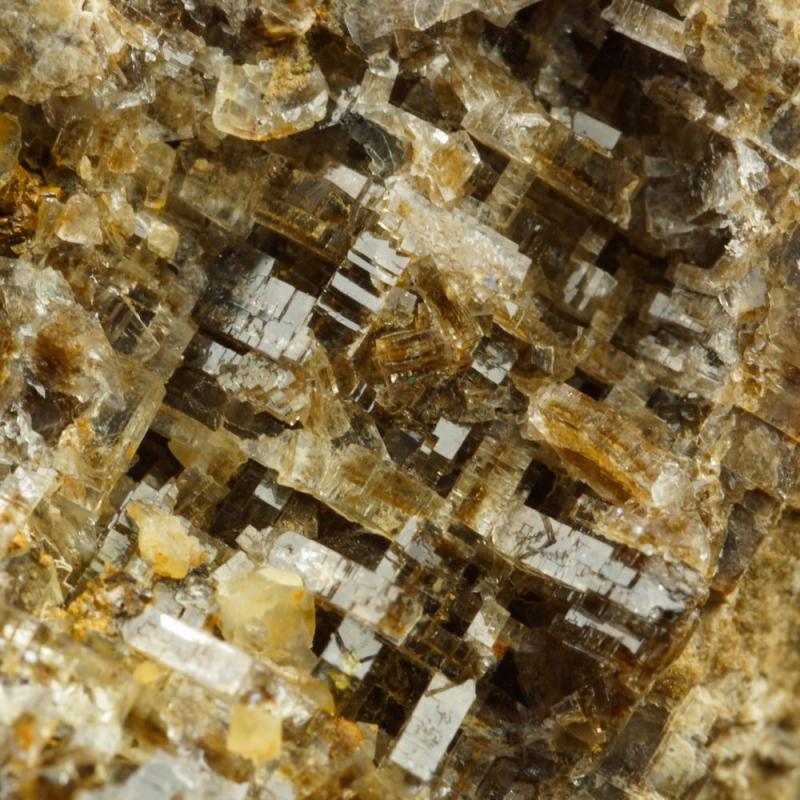
|
| Description: |
Fluorite, elongate crystal
Blackdene Mine, Ireshopeburn, Weardale, Co Durham, UK.
95 mm specimen with 45 mm elongate fluorite (L/W = 5). |
|
| Viewed: |
46190 Time(s) |
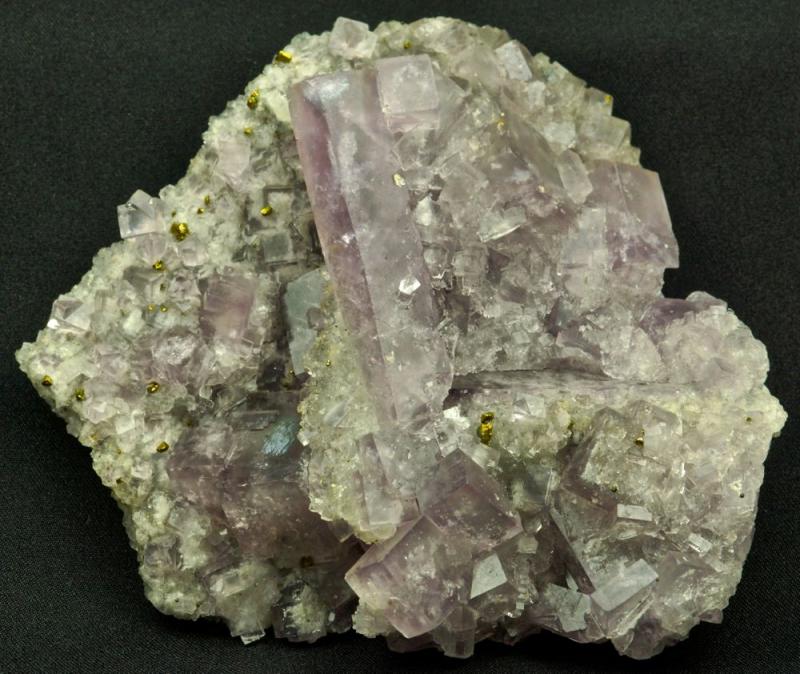
|
| Description: |
Fluorite.
Boltsburn Mine, Weardale, Co Durham, UK.
50 mm long and 25 mm wide. |
|
| Viewed: |
46246 Time(s) |
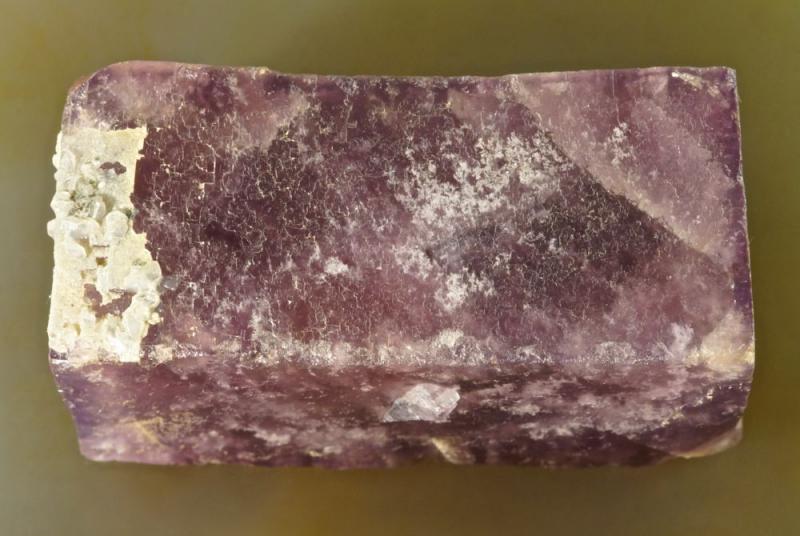
|
|
|
| Back to top |
|
 |
Jesse Fisher

Joined: 18 Mar 2009
Posts: 641
Location: San Francisco



|
 Posted: Mar 23, 2013 14:56 Post subject: Re: Elongate and tabular fluorite crystals - (7) Posted: Mar 23, 2013 14:56 Post subject: Re: Elongate and tabular fluorite crystals - (7) |
|
|
Not sure what the cause is, but here's one of the most extreme examples I've ever seen - Russell collection #1918 in the Natural History Museum, London.
| Description: |
Fluorite
Boltusburn Mine, Rookhope, Weardale, England
approximately 7 cm long |
|
| Viewed: |
46183 Time(s) |
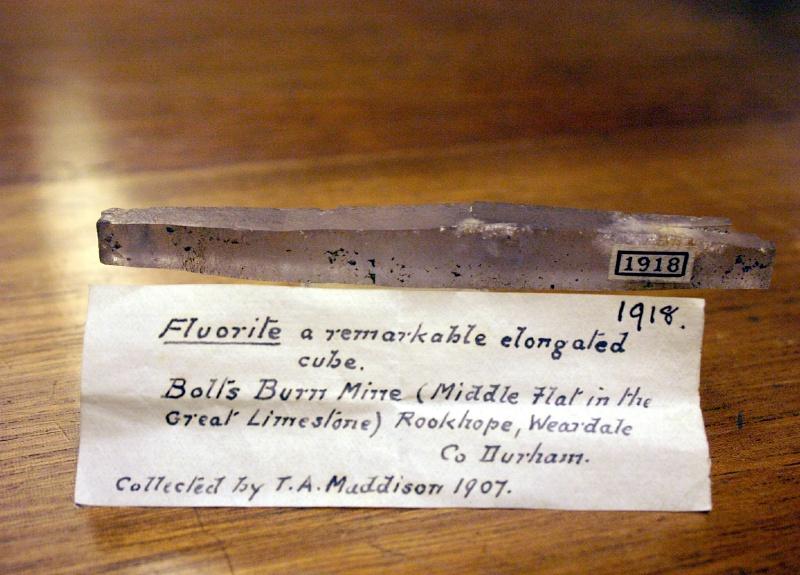
|
|
|
| Back to top |
|
 |
Ru Smith
Joined: 13 Oct 2012
Posts: 362



|
 Posted: Mar 23, 2013 15:03 Post subject: Re: Elongate and tabular fluorite crystals - (7) Posted: Mar 23, 2013 15:03 Post subject: Re: Elongate and tabular fluorite crystals - (7) |
|
|
Wow, spectacular (and thanks for the Blackdene example).
How many different mines have you seen this type of habit from? There seem to be quite a few examples from both Blackdene and Boltsburn.
|
|
| Back to top |
|
 |
Mark Ost

Joined: 18 Mar 2013
Posts: 516
Location: Virginia Beach



|
 Posted: Mar 23, 2013 15:46 Post subject: Re: Elongate and tabular fluorite crystals - (7) Posted: Mar 23, 2013 15:46 Post subject: Re: Elongate and tabular fluorite crystals - (7) |
|
|
| Amazing. County Durham seems to be the source of many remarkable fluorites. What is the setting there?
|
|
| Back to top |
|
 |
Jesse Fisher

Joined: 18 Mar 2009
Posts: 641
Location: San Francisco



|
 Posted: Mar 23, 2013 16:17 Post subject: Re: Elongate and tabular fluorite crystals - (7) Posted: Mar 23, 2013 16:17 Post subject: Re: Elongate and tabular fluorite crystals - (7) |
|
|
Mark - The North Pennines Orefield (of which Weardale is the center) is a classic Mississippi Valley-Type ore deposit, very similar to the fluorite deposits in Southern Illinois. The ore deposits are epigenetic, low temperature and form as both fracture-filling veins and horizontal metasomatic replacement deposits, which are formed within bedded limestones. For a more detailed description (with respect to specimen mineralogy) see the Jan/Feb 2013 issue of Rocks & Minerals.
Ru - though Blackdene and Boltsburn are the best-known localities in Weardale for these elongate fluorites, I've seen them from other mines as well. Below is a photo of one we found at the Rogerley a couple years back.
| Description: |
fluorite
Rogerley Mine, Weardale, Co. Durham, England
7x6x5 cm overall size
an odd, tabular fluorite crystal, with some inter-facial angles that deviate from 90 degrees. |
|
| Viewed: |
46128 Time(s) |
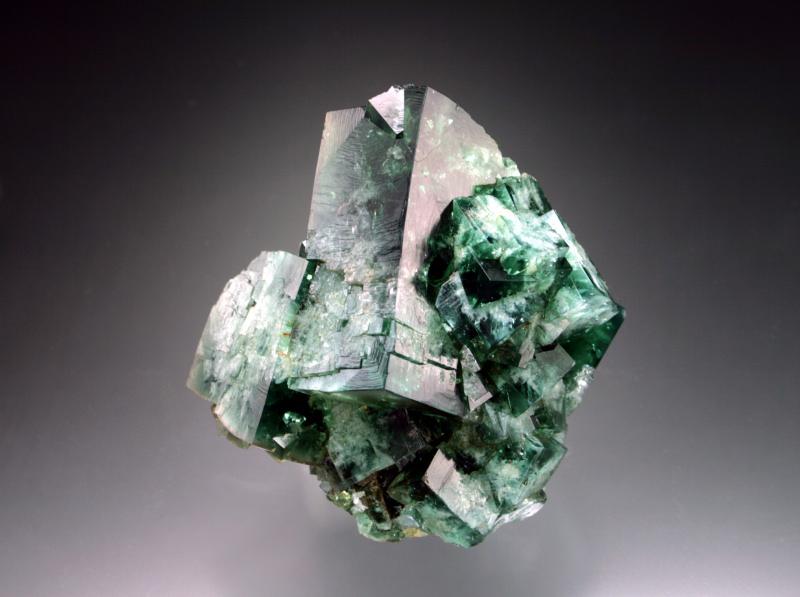
|
|
|
| Back to top |
|
 |
Malcolm Southwood
Joined: 04 Feb 2011
Posts: 15
Location: Melbourne



|
 Posted: Mar 23, 2013 16:42 Post subject: Re: Elongate and tabular fluorite crystals - (7) Posted: Mar 23, 2013 16:42 Post subject: Re: Elongate and tabular fluorite crystals - (7) |
|
|
Ru, Jesse,
By coincidence I've just been doing some reading on the development of skeletal cuprite crystals and, ultimately, acicular ones (chalcotrichite).
My understanding is that these elongated crystals develop by means of a screw dislocation in the lattice on one of the faces. The resulting "step" on that face, albeit minute, provides a site for preferential nucleation, leading to accelerated growth for that particular face and, ultimately therefore, to an "elongated cube". I also understand that an over-saturated solution favours the development of such crystals.
I can thoroughly recommend Boris Kantor's "Crystal Growth and Development" published as Mineralogical Almanac, Volume 6 (2003).
Hope this helps,
mal
|
|
| Back to top |
|
 |
Ru Smith
Joined: 13 Oct 2012
Posts: 362



|
 Posted: Mar 23, 2013 18:34 Post subject: Re: Elongate and tabular fluorite crystals - (7) Posted: Mar 23, 2013 18:34 Post subject: Re: Elongate and tabular fluorite crystals - (7) |
|
|
Many thanks, Malcolm, I'll get a copy of that.
This explanation made me think of the attached elongate pyrite inclusions in a crystal of fluorite from Hawes, Yorkshire.
| Description: |
Pyrite in fluorite
East Flatt, Raygill Mine, Hawes, Wensleydale, Yorkshire, UK.
FOV about 6 mm. Fluorite crystals to 44 mm in 75 mm group. |
|
| Viewed: |
46105 Time(s) |
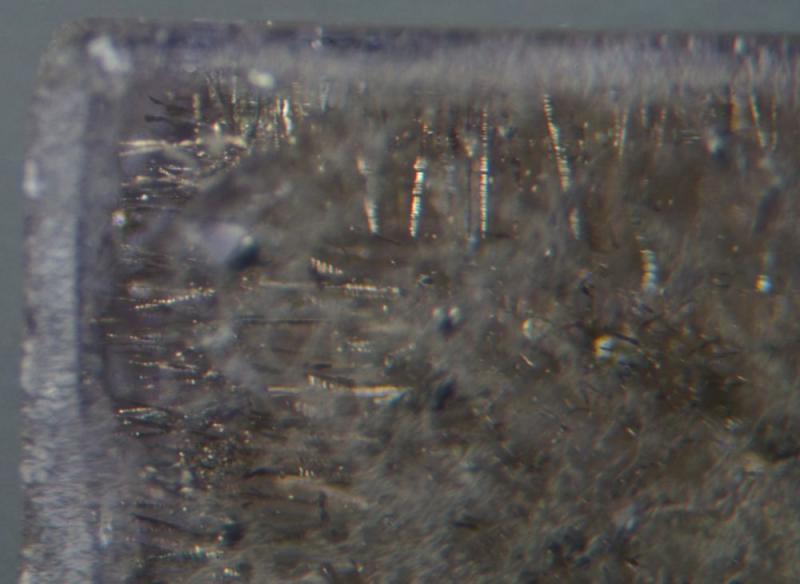
|
| Description: |
Pyrite in fluorite
East Flatt, Raygill Mine, Hawes, Wensleydale, Yorkshire, UK.
FOV about 2 mm. |
|
| Viewed: |
46134 Time(s) |
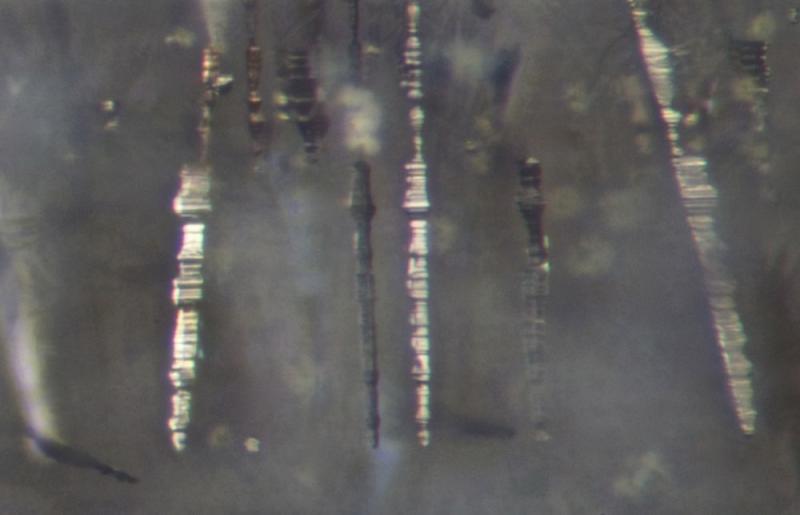
|
| Description: |
Pyrite in fluorite
East Flatt, Raygill Mine, Hawes, Wensleydale, Yorkshire, UK.
FOV about 2 mm. |
|
| Viewed: |
46080 Time(s) |
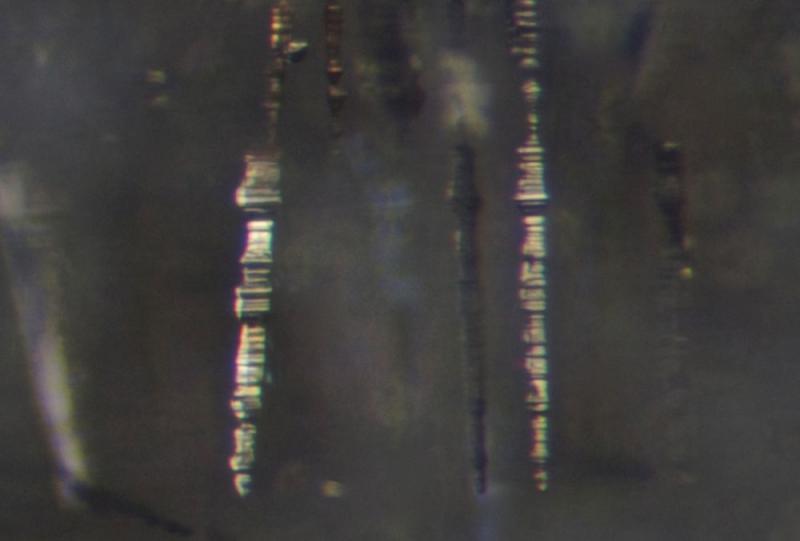
|
|
|
| Back to top |
|
 |
Ru Smith
Joined: 13 Oct 2012
Posts: 362



|
 Posted: Mar 23, 2013 18:37 Post subject: Re: Elongate and tabular fluorite crystals - (7) Posted: Mar 23, 2013 18:37 Post subject: Re: Elongate and tabular fluorite crystals - (7) |
|
|
| and nice Rogerley specimen, Jesse.
|
|
| Back to top |
|
 |
Pete Richards
Site Admin
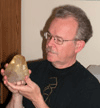
Joined: 29 Dec 2008
Posts: 846
Location: Northeast Ohio



|
 Posted: Mar 23, 2013 18:37 Post subject: Re: Elongate and tabular fluorite crystals - (7) Posted: Mar 23, 2013 18:37 Post subject: Re: Elongate and tabular fluorite crystals - (7) |
|
|
| Malcolm Southwood wrote: | Ru, Jesse,
By coincidence I've just been doing some reading on the development of skeletal cuprite crystals and, ultimately, acicular ones (chalcopyrite).
My understanding is that these elongated crystals develop by means of a screw dislocation in the lattice on one of the faces. The resulting "step" on that face, albeit minute, provides a site for preferential nucleation, leading to accelerated growth for that particular face and, ultimately therefore, to an "elongated cube". I also understand that an over-saturated solution favours the development of such crystals.
I can thoroughly recommend Boris Kantor's "Crystal Growth and Development" published as Mineralogical Almanac, Volume 6 (2003).
Hope this helps,
mal |
This is a well-recognized and well-studied mechanism for forming "whisker" crystals such as chalcotrichite (not chalcopyrite), pyrite, halite, etc. But this is a mechanism that operates at a sub-mm scale - whiskers are millimeters more or less long and tenths of millimeters in cross section. It would be very difficult to explain macro bars such as the fluorites of current discussion in this way - one would have to appeal to many hundreds of screw defects perpendicular to long axis, and none parallel to the other equivalent axes. Why should this be?
Large bars such as these and some large pyrite bars, e.g. from the Buick Mine in Missouri, are to my thinking unexplained, especially when they occur among undistorted crystals of the same mineral!
The only scheme that makes any sense to me is that crystal growth started as a whisker crystal, but this mechanism stopped (why?) after growing a VERY long whisker, and was replaced by normal growth of equal velocity on all crystal faces. This would lead to a reduction in elongation over time from, say, 20:1 to to 10:1 to 4:1 etc. If normal growth dominated, it could even lead to a crystal without discernible elongation. I wonder how one could possibly evaluate this mechanism for a given locality (especially without destroying the distorted crystals).
_________________
Collecting and studying crystals with interesting habits, twinning, and epitaxy |
|
| Back to top |
|
 |
Pete Richards
Site Admin

Joined: 29 Dec 2008
Posts: 846
Location: Northeast Ohio



|
 Posted: Mar 23, 2013 18:51 Post subject: Re: Elongate and tabular fluorite crystals - (7) Posted: Mar 23, 2013 18:51 Post subject: Re: Elongate and tabular fluorite crystals - (7) |
|
|
| Ru Smith wrote: | | ...This explanation made me think of the attached elongate pyrite inclusions in a crystal of fluorite from Hawes, Yorkshire. |
This kind of sulfide inclusion in fluorite and other minerals such as calcite is fairly common in MVT-type deposits (and probably others). My studies suggest that this is a case of balanced growth, where the host and the guest (sulfide) grow at essentially the same rate. If the inclusion grows much faster, it grows beyond the bounds of the host, and takes on its preferred crystal shape (and then the future history determines what we see). If the host grows too fast at some point, the guest gets engulfed and ceases growth. In some cases, the relative growth rates may select for orientations of the guest that are fast-growing.
This suggests epitaxy, but is not - it's more a case of growth competition such as occurs in mono-mineralic associations such as quartz druses.
I think this is one of those situations where our interest in unusual things distorts our perspective. Dealers and collectors will choose and emphasize specimens like the ones Ru has illustrated - long stripes of sulfide enclosed in fluorite or calcite or quartz - but ignore (or interpret differently) hosts with a phantom of small sulfide crystals confined to one growth surface of the host mineral.
_________________
Collecting and studying crystals with interesting habits, twinning, and epitaxy |
|
| Back to top |
|
 |
Ru Smith
Joined: 13 Oct 2012
Posts: 362



|
 Posted: Mar 23, 2013 18:52 Post subject: Re: Elongate and tabular fluorite crystals - (7) Posted: Mar 23, 2013 18:52 Post subject: Re: Elongate and tabular fluorite crystals - (7) |
|
|
| What do you make of these micro pyrite columns, Pete? There is a "microstratigraphic" record of narrowing and widening showing the same pattern in all of the columns caught in the photos.
|
|
| Back to top |
|
 |
Mark Ost

Joined: 18 Mar 2013
Posts: 516
Location: Virginia Beach



|
 Posted: Mar 23, 2013 18:56 Post subject: Re: Elongate and tabular fluorite crystals - (7) Posted: Mar 23, 2013 18:56 Post subject: Re: Elongate and tabular fluorite crystals - (7) |
|
|
Interesting. It would seem basic that the face of rapid growth would have unsatisfied electrical bonds making it a site for accelerated growth vs. those sites that have stable configurations. I suppose the "ledge" created by a screw dislocation, on the C axis, would result in elongated growth along that direction. But why it occurs I have no idea. Random variation or chemical causes?
Like my mineralogy professor said "People, like crystals, grow on their imperfections".
Doubt that helps but sounds good.
|
|
| Back to top |
|
 |
Pete Richards
Site Admin

Joined: 29 Dec 2008
Posts: 846
Location: Northeast Ohio



|
 Posted: Mar 23, 2013 18:57 Post subject: Re: Elongate and tabular fluorite crystals - (7) Posted: Mar 23, 2013 18:57 Post subject: Re: Elongate and tabular fluorite crystals - (7) |
|
|
| Ru Smith wrote: | | What do you make of these micro pyrite columns, Pete? There is a "microstratigraphic" record of narrowing and widening showing the same pattern in all of the columns caught in the photos. |
Our messages may have crossed... but those oscillations are typical, and I presume they represent small changes in the relative growth rates of fluorite and pyrite. I don't know what the mechanism is - I will definitely not suggest annual growth rings! Perhaps an oscillation in pH or Eh? It would be fascinating to be able to put a time scale on those - are they annual, decadal, millennial?
_________________
Collecting and studying crystals with interesting habits, twinning, and epitaxy |
|
| Back to top |
|
 |
Mark Ost

Joined: 18 Mar 2013
Posts: 516
Location: Virginia Beach



|
 Posted: Mar 23, 2013 19:02 Post subject: Re: Elongate and tabular fluorite crystals - (7) Posted: Mar 23, 2013 19:02 Post subject: Re: Elongate and tabular fluorite crystals - (7) |
|
|
| Pete is it possible that as the crystal grows it depleted the fluid it draws from and reaches a chemical state that then allows normal growth, somewhat like magma differentiation?
|
|
| Back to top |
|
 |
Pete Richards
Site Admin

Joined: 29 Dec 2008
Posts: 846
Location: Northeast Ohio



|
 Posted: Mar 23, 2013 19:26 Post subject: Re: Elongate and tabular fluorite crystals - (7) Posted: Mar 23, 2013 19:26 Post subject: Re: Elongate and tabular fluorite crystals - (7) |
|
|
| Mark Ost wrote: | | Pete is it possible that as the crystal grows it depleted the fluid it draws from and reaches a chemical state that then allows normal growth, somewhat like magma differentiation? |
We're having a little trouble keeping themes separate here, but i am going to answer this assuming it pertains to whisker growth rather than to competitive growth of e.g. pyrite in fluorite.
It is a normal observation in laboratory experiments that whiskers grow fast and long, and then later or even simultaneously normal crystal growth thickens the whiskers over time. The problems is that there are at least three separate mechanisms of whisker growth, and it is not clear that all of them operate under conditions that would lead to later thickening, or even operate under typical geological conditions.
In particular, growth around screw defects is sometime suggested as a mechanism for continuing (or permitting) growth when supersaturation is too low to grow normal crystals. In this case, one would not expect thickening of the whisker unless low or declining concentrations were reversed.
While there may be some ways to unlock the history of crystal growth in specific conditions, Nature runs a sloppy laboratory, and this makes understanding of details difficult at best!
_________________
Collecting and studying crystals with interesting habits, twinning, and epitaxy |
|
| Back to top |
|
 |
|





